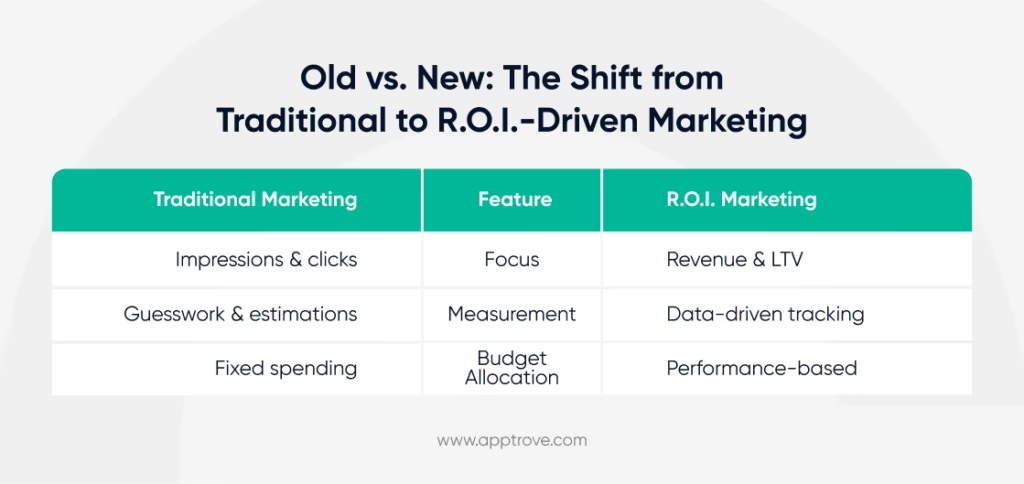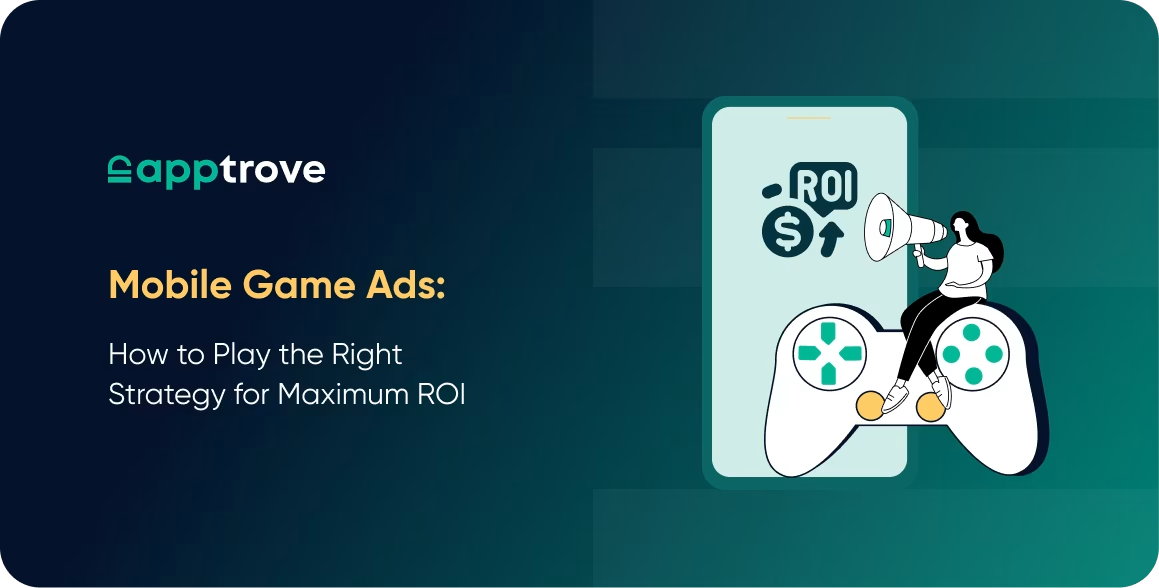The global app industry will reach over 1.87 trillion U.S. dollars in marketing spend in the year 2025, but the vast majority of marketers are unable to measure their impact. As privacy regulations limit tracking and user acquisition costs climb, businesses can no longer afford to guess or go by outdated performance metrics.
In mobile marketing, R.O.I. (Return on Investment) is measured based on how good an app is in attracting, engaging and retaining users. R.O.I. marketing is a data-driven approach to evaluate the success of ads and promotional campaigns. It enables brands to measure returns against their marketing investments and make choices that will lead to long-term success.
In contrast to traditional marketing metrics that focus on impressions and engagement, R.O.I. marketing connects every action to revenue, retention, and business growth. From the first ad impression to in-app engagement and repeat buys, each step is part of an app’s profitability.
The true objective of marketing isn’t to create brand awareness or engagement but to ensure each spent dollar returns measurable value. Yet to most marketers, R.O.I. is still an enigma with fragmented data, changing algorithms, and a customer path that no longer follows a linear path. With Apptrove, marketers can ensure each dollar spent on marketing is accountable, measurable and optimized for maximum impact and sustainable growth.

Why R.O.I. Marketing is Important for App Success
Gone are the days when marketing success was measured in likes, impressions, and vanity metrics. Today, 83% of marketing leaders prioritize ROI Marketing tracking, a significant jump from just a few years ago. Businesses that understand their returns scale faster, optimize smarter and spend better.
Yet, despite its importance, ROI Marketing remains tricky for many. 47% of marketers admit they struggle with multi-channel attribution, and 36% still find ROI measurement challenging due to scattered data and inconsistent tracking. That’s where the right tools come in. Solutions like Apptrove bridge this gap, offering marketers clarity on which campaigns drive revenue and which are just burning budgets.
Effective R.O.I. marketing ensures that marketing spend aligns with business goals. In the app industry, high acquisition costs make it necessary to focus not just on bringing in users but on ensuring those users generate long-term value. Without a clear understanding of R.O.I., app businesses risk overspending on campaigns that do not deliver sustainable returns.
Optimize Budget To Minimize Ad Spend
Marketers must strategically allocate their budgets to channels demonstrating the greatest effectiveness due to rising user acquisition costs. R.O.I. marketing provides insights into which campaigns captivate high-value users so marketers can adjust spending to maximize returns.
Retention Over Acquisition
It takes five times more money to acquire a new user compared to retaining an existing user. A strong R.O.I. marketing strategy aims to acquire users and maintain their ongoing engagement. Personalized offers combined with deep linking and seamless user experiences serve as fundamental retention tactics that help generate sustained revenue.
Better Marketing with Data Insights
By analyzing campaign performance through R.O.I. marketing, businesses can enhance their messaging effectiveness while optimizing targeting and promotional strategies. Using an iterative approach allows businesses to enhance their outcomes while maintaining competitiveness within the app marketplace.
The Biggest R.O.I. Marketing Challenges and How to Overcome Them
Despite its importance, marketers must find ways to overcome multiple challenges presented by R.O.I. marketing. The complexity of measuring and optimizing R.O.I. in mobile marketing stems from fragmented user journeys and the development of new privacy regulations.
Attribution Complexity
One of the biggest challenges in R.O.I. marketing involves correctly identifying which channels lead to conversions. The last-touch attribution model assigns credits to the final interaction immediately before a user takes a conversion action. Although this method streamlines tracking processes, marketers need to recognize that user behavior is shaped by multiple interaction touchpoints.
Data Fragmentation
App users interact through various platforms including social media advertisements, organic search results as well as in-app advertisements. A comprehensive tracking solution that integrates data from different channels is necessary to measure R.O.I. and obtain an accurate view of user behavior across these platforms.
Privacy Regulations
The growing number of data privacy regulations restricts marketers’ access to user data which complicates campaign performance measurement. Marketers in the app marketing industry must transition to privacy-first tracking solutions while continuing to maximize their return on investment.

Measuring R.O.I. Marketing at Every Stage of the User Journey
A strong R.O.I. marketing strategy prioritizes evaluating success throughout the entire user lifecycle rather than aiming for immediate conversions. These stages include acquisition, engagement, retention, and revenue generation.
Acquisition Metrics
The R.O.I. measurement process begins with analyzing both cost per install (CPI) and cost per acquisition (CPA). These metrics help assess how efficiently users are being brought into the app and whether the acquisition costs are justified by user value.
Engagement and Retention Metrics
Beyond initial installs, monitoring metrics like session duration, feature adoption rates, and churn rates help determine if users are finding value in the app. Strong engagement leads to better retention and long-term revenue growth.
Revenue Metrics
The financial success of marketing campaigns becomes clear through tracking revenue per user as well as lifetime value (LTV), and return on ad spend (ROAS) metrics. A comparison between marketing costs and revenue generated allows businesses to enhance their R.O.I. marketing strategies.
Five Data-Driven Strategies for Better R.O.I. Marketing
If app businesses want to get the most out of marketing, they need to go for a precise and data-driven approach. Five strategic moves that will significantly increase R.O.I. marketing include the following:
1. Precision Targeting and Segmentation
It gives you a better understanding of user segments and helps you target the users with the right messaging, all of which results in higher conversion rates. Marketers are able to refine their campaigns based on behavioral data, purchase history as well as in-app interactions.
2. Deep Linking for Seamless Experiences
A broken user journey can lead to drop-offs and a wasted marketing budget. Unilink makes sure users land right where they need to be within the app, improving conversions and R.O.I.
3. Retargeting High-Intent Users
Rather than using all your effort on acquiring new users, retargeting users who have previously engaged with the app results in higher retention and revenue. Some retargeting strategies like personalized push notifications and email campaigns are helpful to re-engage the users who already knew the brand.
4. Optimizing Paid Campaigns
Paid marketing tactics such as Google Ads and social media campaigns must be constantly optimized. Analyzing which keywords, creatives, and ad placements yield the highest returns helps marketers budget more wisely and optimize R.O.I. overall.
5. Performance-Based Partnerships
Collaborating with affiliates and publishers on a performance-based model ensures that marketing expenditure is aligned with real outcomes. By paying partners based on actual conversions instead of simple impressions or clicks, businesses can obtain more cost-efficient user acquisition.
Summing Up
Marketing isn’t merely about being noticed but about being remembered and driving action. Without strong R.O.I. marketing measures, brands are actually flying blind, hoping their efforts pay off. The most intelligent businesses don’t just measure performance but instead optimize, and enhance based on measurement.
With Apptrove’s data analytics, brands no longer have to make assumptions about what’s working. Whether it’s last-touch attribution, deep linking, or actionable insights, R.O.I. marketing is now smarter, faster, and more precise than ever. The time has come to look beyond superficial analytics and take control of your R.O.I. marketing because in the mobile app marketing world, the brands that track better win bigger.
FAQs
1. What is marketing ROI, and why does it matter?
Marketing ROI, or return on investment, measures how much money a business makes from its marketing efforts compared to what it spends. It helps companies understand if their marketing strategies are actually driving revenue or just burning cash.
2. How do you calculate marketing ROI?
The simplest formula to calculate marketing ROI is:
(Total Revenue – Marketing cost) ÷ Marketing cost × 100
For example, if a business spends $10,000 on a campaign and earns $50,000 in revenue, the calculation would be:
($50,000 – $10,000) ÷ $10,000 × 100 = 400% ROI
This means the campaign returned four times the amount spent.
3. What is considered a good marketing ROI?
A good marketing ROI is typically 5:1, meaning the campaign generates $5 for every $1 spent. This translates to a 400% ROI. An exceptional campaign can achieve a 10:1 ratio, which equals 900% ROI. However, what qualifies as a “good” ROI depends on the industry and profit margins.
4. Why is marketing ROI more important than metrics like clicks and impressions?
Clicks and impressions can look impressive, but they don’t always translate into revenue. Marketing ROI focuses on real business impact by measuring actual returns instead of just engagement. A campaign might get thousands of clicks, but if those clicks don’t turn into sales, it’s not really successful.
5. What makes marketing ROI difficult to measure?
Some of the biggest challenges in measuring marketing ROI include:
– Figuring out which marketing channel actually led to a sale
– Tracking offline and online customer journeys
– Dealing with data restrictions and privacy laws
– Understanding long-term brand impact beyond immediate sales






